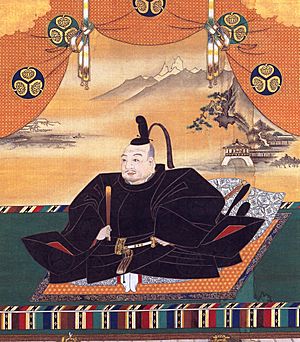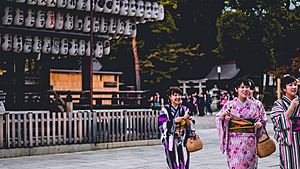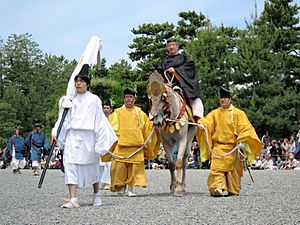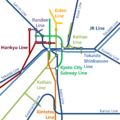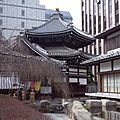Kyoto Prefecture facts for kids
Quick facts for kids
Kyoto Prefecture
|
|||
|---|---|---|---|
|
|||
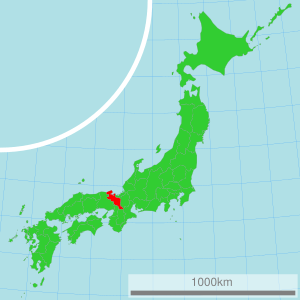 |
|||
| Country | Japan | ||
| Region | Kansai | ||
| Island | Honshu | ||
| Capital | Kyoto | ||
| Subdivisions | Districts: 6, Municipalities: 26 | ||
| Area | |||
| • Total | 4,612.19 km2 (1,780.78 sq mi) | ||
| Area rank | 31st | ||
| Population
(October 1, 2015)
|
|||
| • Total | 2,610,353 | ||
| • Rank | 13th | ||
| • Density | 566/km2 (1,470/sq mi) | ||
| ISO 3166 code | JP-26 | ||
| Website | www.pref.kyoto.jp | ||
| Symbols | |||
| Bird | Streaked shearwater (Calonectris leucomelas) | ||
| Flower | Weeping cherry blossom (Prunus spachiana) | ||
| Tree | Kitayama Sugi (Cryptomeria japonica) | ||
Kyoto Prefecture is a special area, like a state, in Japan. It's located in the Kansai region on the big island of Honshu. The main city and capital of Kyoto Prefecture is Kyoto City.
Contents
A Look at Kyoto's Past
Long ago, before a big change called the Meiji Restoration, the area we now call Kyoto Prefecture was known as Yamashiro.
For a very long time, Kyoto City was the capital city of Japan, where the Emperor lived. Its history goes back to the 500s! In 544, a festival called the Aoi Matsuri was held in Kyoto. People prayed for good harvests and nice weather.
Kyoto wasn't always the capital. An earlier capital was Nara. In 741, Emperor Shōmu briefly moved the capital to Kuni-kyo. This place is now part of Kyoto Prefecture, between Nara and Kyoto cities.
In 784, the capital moved again to Nagaokakyo, also in present-day Kyoto Prefecture. Then, in 794, Emperor Kanmu moved the capital to Heian-kyō. This was the start of the modern city of Kyoto. Even today, many streets, houses, and temples in Kyoto are still in the same places they were built back then.
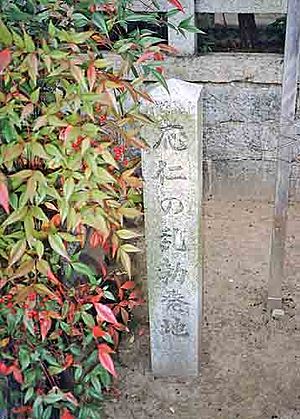
In 1467, a big civil war called the Ōnin War happened right inside Kyoto. Most of the city was burned down. Japan then entered a period of fighting lords, known as the age of warring states. Later, a powerful leader named Tokugawa Ieyasu started a new government in Edo (which is now Tokyo) in 1603.
In the 1400s, special tea jars were brought from the Philippines to Uji in Kyoto. These jars were used by the shōgun (a military ruler) for the Japanese tea ceremony.
The Meiji Restoration in 1868 brought back the Emperor's rule in Japan. Emperor Meiji moved to Tokyo the next year. The imperial court has stayed in Tokyo ever since.
After this big change, the area of Kyoto was reorganized. Parts of old provinces like Tango, Yamashiro, and Tanba were combined to form today's Kyoto Prefecture.
Even though many major Japanese cities were bombed during World War II, Kyoto was spared. It didn't suffer the same terrible damage. During the time Japan was occupied after the war, the U.S. Sixth Army had its main office in Kyoto.
Kyoto's Location and Nature

Kyoto Prefecture is located almost in the middle of Honshu, Japan's largest island. It covers about 4,612 square kilometers, which is 1.2% of Japan's total land. Kyoto is the 31st largest prefecture.
To the north, Kyoto faces the Sea of Japan and Fukui Prefecture. To the south, it borders Osaka and Nara Prefecture. To the east, it's next to Mie and Shiga Prefecture. To its west is Hyōgo Prefecture.
The Tanba Mountains run through the middle of the prefecture. This causes the northern and southern parts of Kyoto to have very different climates. About 21% of Kyoto's land is protected as Natural Parks.
What Kyoto Makes and Does

Kyoto Prefecture's economy is special because it focuses on things unique to Kyoto. This includes tourism and traditional industries. These industries are supported by over 1,200 years of history and culture. Kyoto also has high-tech industries that mix old traditions with new ideas.
In northern Kyoto, especially on the Tango Peninsula, people work in fishing and water transportation. In the middle of Kyoto, farming and forestry are important. The prefecture produces 13% of Japan's sake (a type of rice wine) and green tea. Japan's biggest vertical farm is also located here.
Kyoto's Rich Culture
Kyoto has always been, and still is, a major cultural center in Japan. For over 1,000 years, it was Japan's capital city. Even when the capital moved to Tokyo, Kyoto remained important for its culture.
There's a plan to move the Agency for Cultural Affairs to Kyoto. This would make Tokyo the capital for politics and business, and Kyoto the capital for culture.
Exploring Kyoto: Fun for Tourists
Kyoto City is one of the most popular places for tourists in Japan. Many people from all over the world come to visit. Along with Tokyo, Kyoto is a favorite spot for junior high and high school graduation trips.
Many famous festivals are held in Kyoto. These include the Aoi Matsuri (since 544), Gion Matsuri (since 869), Ine Matsuri (from the Edo period), Daimonji Gozan Okuribi (since 1662), and Jidai Matsuri (since 1895). Every shrine and temple in Kyoto also holds events, and many are open for everyone to see.
Defense and Security
In 2013, a USFJ missile monitoring station was approved for the city of Kyōtango. It shares a location with a JASDF facility already there.
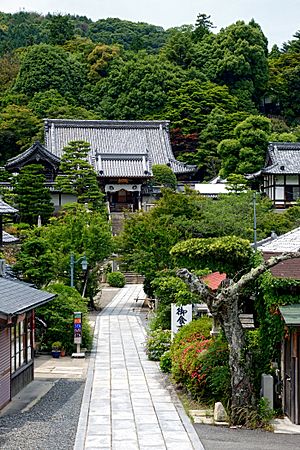
This station uses a special X-band radar to collect information on ballistic missile launches. This information is then sent to warships with Aegis air defense systems and to ground missile sites. About 160 people work at this station.
Related pages
- Provinces of Japan
- Prefectures of Japan
- List of regions of Japan
- List of islands of Japan
- Kyoto Sanga F.C.
Images for kids
-
Nagaoka-kyō, a former Capital of Japan in Otokuni Palace
-
Map of Kyoto Prefecture Designated City City Town Village
-
Tōkaidō Shinkansen arriving at Kyoto Station
-
Japanese tea plantation
-
Rokkaku-dō, where a school of the Japanese flower arrangement originated from.
See also
 In Spanish: Prefectura de Kioto para niños
In Spanish: Prefectura de Kioto para niños





